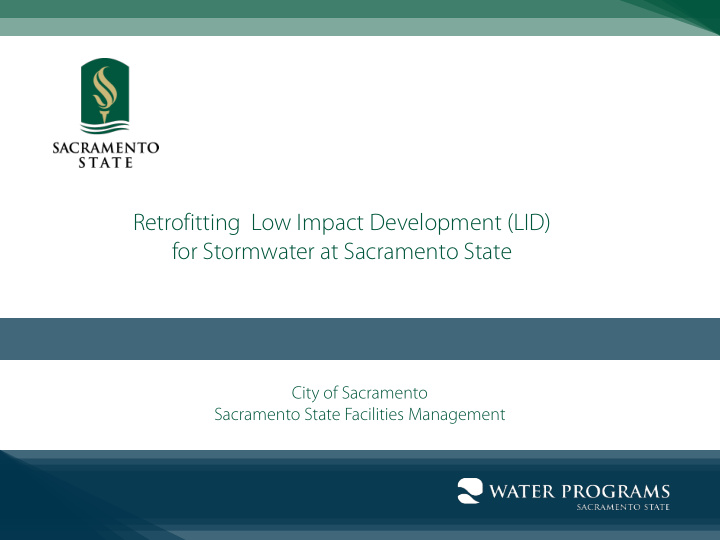



Retrofitting Low Impact Development (LID) for Stormwater at Sacramento State City of Sacramento Sacramento State Facilities Management
Project Background – Campus Storm Drain System Drain Inlet - Campus Storm Drain Discharges into American River
Project Background – American River Upstream Discharge Outfall – Guy West Bridge Sample Sample
Project Background 1. Phase II Stormwater Permit Requires Implementation of Low Impact Development Kevin Perry - Urban Rain Design
Project Background 1. Proposition 84 – Stormwater Grant Program 2. State Water Resources Control Board 3. Objectives: a) Prevent stormwater contamination of rivers, lakes, and streams. b) Implement requirements of stormwater permits c) Implement Low Impact Development (LID) d) Monitoring and Education Outreach City of Kirkland, WA
Project Collaboration State Water Resources Control Board City of Sacramento Project Management Design and Construction Oversight Office of Water Programs @ Sacramento State/UEI Stormwater Monitoring and Evaluation Public Education and Outreach Sacramento State Facilities Management Design and Construction Contractors
Project Funding - Summary Project Total - $3.3M A. Prop 84 - $2.6M B. Local Match - $0.7M i. Sacramento State FM - $500K ii. City of Sacramento - $112K iii. Office of Water Programs – $31K iv. Dry Creek Conservancy - $30K v. Local LID Expertise - $25K vi. County of Sacramento - $1K
Project Benefits 1. Meet Stormwater Permit Requirements 2. Faculty/Student Involvement 3. High Visibility 4. Protects the American River 5. Replenish Irrigation Wells 6. Demonstration and Training Facility for Northern CA
Low Impact Development (LID) 1. Mimic Natural Hydrology (Infiltrate) 2. Protect Receiving Waters 3. Reduce Flooding 4. Groundwater Recharge 5. Opportunities for Reuse US EPA
Types of Low Impact Development Devices 1. Bioretention Planters 2. Rain Gardens 3. Bioswales 4. Porous Pavement 5. Biostrips 6. Road Narrowing (reduce impervious area) 7. Cisterns or Rain Barrels 8. Tree Box Filters 9. Constructed Wetlands 10. Green Roofs
Rain Garden Profile and Function Surface depth 6” Amended Soil depth 18” Native Soil 11
Rain Gardens US EPA Harford County, MD
Bioswale - Profile 6” height Amended Soil: 6” – 18 ” Native Soil
Bioswales Caltrans Lake County, IL
Bioretention Profile and Function Surface depth 6” Amended Soil depth 18” Elevated Underdrain Discharge Underdrain storage depth 12” Native soil 15
Bioretention – Parking Lots Scott Taylor, PE RBF Consulting
Bioretention – Streets Scott Taylor, PE RBF Consulting
Porous Pavement - Profile 4” Porous Pavement Gravel Filter Course 12” Native Soil
Porous Pavement
Project Location
Campus Layout
Ongoing LID Construction 1. 8 Bioretention Planters 2. 8 Rain Gardens (Street Side and Low Lying Lawn Drain Inlets) 3. 3 Rooftop Disconnects with Rain Gardens 4. 2 Bioswales 5. 1 Green Street (Porous Pavement and 6-10 Rain Gardens)
Design Goals Enhance Infiltration A. Silty sands over gravels B. No devices lined C. 14 acre-feet per year infiltrated or treated D. 13.2 acre-feet per year - infiltration alone
Design Goals – Large Tributary Areas 1.82 Acres 1.64 Acres Parking Lot 7 (South): Bioretention Planters and Bioswale
Design Challenges 1. Fitting into the existing drainage system a. Horizontal b. Vertical 2. Negotiating the removal of parking stalls 3. Fitting into existing topography 4. Existing infrastructure 5. Interactions with buildings 6. Subsurface soil? 7. Timing 8. Compatibility with Campus Master Plan
LID Device Monitoring Performance Monitoring Evaluation and Reporting
Education and Outreach 1. Signage, Website, Tours (Mobile App) 2. Brochures 3. Conferences and Papers Green Side Up Kitsap Conservation District 4. LID Conference 5. Campus Presentations 6. Public Affairs
Operation and Maintenance 1. Weed, Litter, and Debris Removal (As needed) 2. Infiltration Inspections (Runoff Infiltrating?) (Twice a year during storms) 3. Low or no Infiltration? Remove and Replace Topsoil (~ 5 to 10 years) 4. Use integrated pest management (IPM) techniques to minimize use of fertilizers, pesticides and herbicides. (As needed) 5. Inspect (~ 2 times per year – including once at end of wet season) for erosion and sediment buildup. Correct problems as needed. Kevin Perry Urban Rain Design
Project Funding - Summary Project Total - $3.3M A. Project Admin: $0.2M B. Planning and Design: $0.5M C. Construction: $2.1M D. Monitoring and Reporting: $0.3M E. Education and Outreach: $0.3M
Project Timeline Spring 2015: Completed Design Summer and Fall 2015: Construction 2015/2016: Post-Construction Monitoring January 2017: Final Report 2016 – 2036: O&M
Breaking Ground • Next Year? Construction Challenges
Project Funded by SWRCB Funding for this project has been provided in full or in part through an agreement with the State Water Resources Control Board. The contents of this document do not necessarily reflect the views and policies of the State Water Resources Control Board, nor does mention of trade names or commercial products constitute endorsement or recommendation for us.
Recommend
More recommend